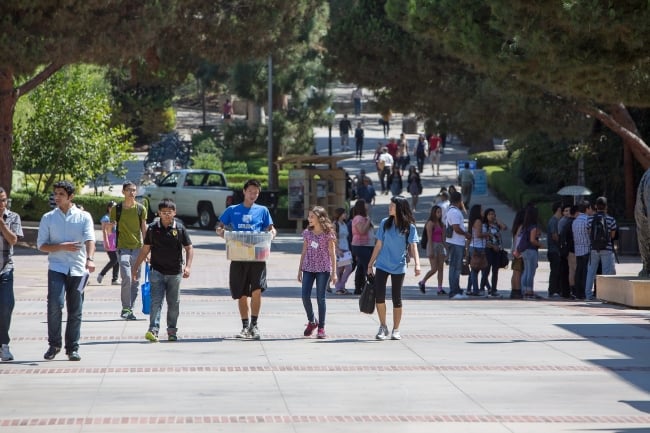You have /5 articles left.
Sign up for a free account or log in.

The University of California system is considering a cap on out-of-state students.
University of California at Los Angeles
Public universities are using non-need-based aid to recruit out-of-state students, at the expense of low-income and in-state students.
That’s the thesis of a report released today by New America.
Public colleges that provide substantial amounts of what they call merit aid to students tend to enroll more nonresident students -- and have experienced a greater decline in resident students over the past 15 years -- than their peers that don't use that strategy, the report found. They also tend to enroll fewer students with Pell Grants and charge low-income students a higher average net price than colleges that provide little merit aid.
Out-of-state enrollment at the University of South Carolina, for example, has more than doubled since 2000, and is now at 45 percent. South Carolina's enrollment manager has said the university increased its nonresident enrollment due to financial necessity, as state funding has dropped by 50 percent since the recession. The State, a Columbia, S.C., newspaper, reported that about 60 percent of out-of-state students receive non-need-based aid.
Part of the reason is that state appropriations have declined dramatically, and some states are experiencing a decline in the number of high school graduates they see each year. Others are so sparsely populated, they have little choice but to go after out-of-state students in an effort to maintain enrollment.
Yet a primary driver is the one the report terms a less necessary one: colleges are competing with one another, and often out-of-state students help boost test scores and overall revenue and thus increase a college's ranking and stature.
“Public higher education has changed. There was a point in time where schools were fairly low priced, serving primarily in-state students. What financial aid they gave out was primarily need-based aid,” said Steve Burd, the primary author of the report and an analyst with New America.
Now, four-year colleges spend less than half of the $9 billion in undergraduate institutional grants they award each year on need-based aid, the report found.
“There’s this general question about the mission of public higher education, and whether schools are abandoning that mission,” Burd continued.
Eighteen percent of public four-year colleges provide at least 20 percent of their students some amount of non-need-based aid, and 48 percent provide at least 10 percent of their students with merit aid.
The aid, more and more, Burd says, is being used to recruit out-of-state students, but it also goes toward keeping well-performing in-state applicants in their home states.
There are generally two ways public institutions can offer merit aid to out-of-state students, says Nate Johnson, a Tallahassee, Fla.-based higher education analyst who specializes in enrollment management.
Out-of-state tuition is usually much higher than in-state tuition, and has been rising more rapidly than in-state tuition. For example, at the University of Virginia, the University of Michigan and the University of North Carolina, nonresident tuition was more than triple the cost of resident tuition in 2013.
Because out-of-state tuition is usually higher than the cost of providing an education, colleges can offer just enough merit aid to entice an applicant to enroll. In many cases, the student will still pay more than the cost of education, and that additional money can go toward subsidizing in-state students.
Officials at Michigan, where out-of-state enrollment is 43 percent, an all-time high, have adopted a strategy of using revenue from out-of-state tuition increases to subsidize need-based aid for in-state students.
Yet such a strategy can mean less economic and racial diversity.
“It’s sort of unfortunate that such students consist only of upper-middle-class students whose families can afford it,” Johnson said.
The other strategy colleges use is more damaging to in-state students: colleges will offer out-of-state students large chunks of merit aid in order to increase their ranking profile, leaving less money for needy students.
“What I worry about is where the discounts are going way below the cost of instruction, to students who don’t need that discount to attend college,” Johnson said. He added that such a practice equates to needlessly shifting students from one state to another just to enhance an institution's ranking.
“Even if you disagree with the rules the way they are, it’s hard to unilaterally disarm,” Johnson said. “If you’re the only institution that’s not willing to do this, then the others who are willing to are going to eat your lunch.”
The New America report says such practices are not isolated to flagship campuses, but are increasingly common at state regional colleges, the report contends. Forty percent of the 277 regional colleges reviewed for the report provided at least 10 percent of their students non-need-based aid. Chasing out-of-state students has become so prevalent, the report says, that an enrollment manager for the University of Kentucky, where 22 percent of students receive non-need-based aid, was prompted to ask, “How do we stop this cycle and change things?”
Some states have limits on the percentage of out-of-state students public colleges can enroll. At University of North Carolina campuses, no more than 18 percent of students can hail from outside the state. Other caps are less restrictive, like the Colorado Legislature’s 45 percent cap on out-of-state freshmen at the University of Colorado at Boulder.
Yet some state universities have seen pushback as their out-of-state enrollment increases. The University of California system intentionally increased its enrollment of out-of-state students -- from 6 percent in 2009 to 20 percent last fall -- in order to grow revenue, but UC President Janet Napolitano last fall said she’d consider a limit after outcries from lawmakers and potential students, who claimed the system was enrolling too many out-of-staters.
“Somebody who’s not in a system, who doesn’t have to play that game, needs to create incentives and set rules that put everybody on a level playing field where they will succeed and benefit when they serve low-income and in-state students,” Johnson said. “The burden to fix this problem really falls to states and federal governments, rather than individual institutions.”




